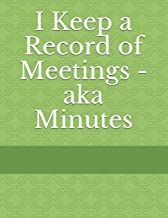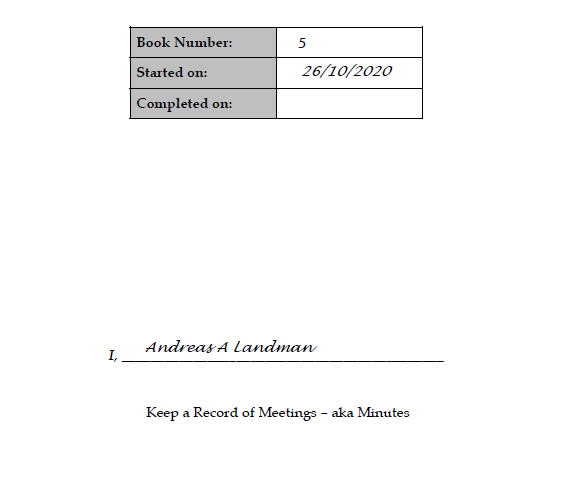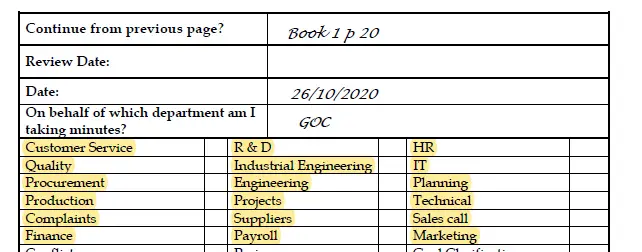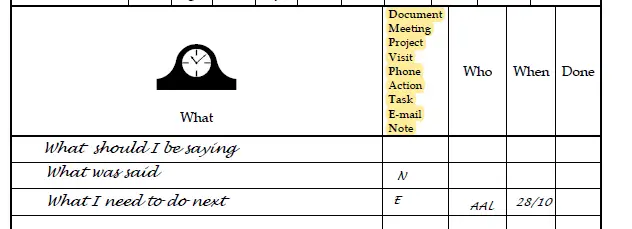
We previously gave you a checklist  to help you make meetings more effective. In this post we look at an Amazon zero-content book
to help you make meetings more effective. In this post we look at an Amazon zero-content book that will help you put what you learnt into practice.
that will help you put what you learnt into practice.

The Inside Front Page – Personalise and Keep Track
Unless you are extremely lucky, you will be spending several hours in meetings and needing to keep track of all of those lost minutes. Thus, the book starts with asking how many books you’ve filled already – now you can reference earlier books and keep similar meetings linked to each other. (Paper books work, they are still a thing. They exist for a reason. Paper books are simultaneously easier and more difficult to search. Up to you.) You would never want to loose your book of minutes, but when you do, you would want to get it back as soon as possible – let people know whose book they picked up.

Prepare for the Meeting – Who are You Representing, Which Department are you focusing on?

As mentioned above, reference these minutes to previous minutes for the same type of meeting. Next, if wear different hats, decide which hat you are wearing to the meeting? Do you represent a specific department, the company as a whole, or even your self in a “Private” meeting?
Which departments will the meeting be focusing on? This also helps you decide who must attend the meeting and will bring value to the discussion.
Preparation – What Is the Goal of Meeting?

Meetings can have different goals, each goal implies a different mindset. Each mindset brings with it a set of emotions. Be in the moment. Prepare yourself mentally for the meeting and its battles.
Preparation – What Is the Core of the Meeting?

Meetings have different cores – the core being determine by how the meeting links to other events. When you make your decision here, you also have the opportunity to put your data (your evidence) together. Make sure you are armed with facts and not shooting yourself in the foot on the quick draw.
Preparation – What is the level of the Meeting?

The focus of the meeting can be at different levels – some meetings go into every nook and cranny of the facts to make sure the right decision – the right word, the right punctuation is used. Thankfully other meetings are for looking at the high-level issues. Do not allow a factual meeting to deteriorate into a drama session. Be decisive.
Preparation – Are we Talking or Deciding?

People want to come to a meeting prepared. You are busy preparing for the meeting. Now, you decide who needs to bring what to the meeting. Do you want to share facts, make decisions or merely share what the powers above have decided? Importantly, you must create the correct expectation of the meeting. If the attendees expect that a decision is going to be made, you better confirm or temper that expectation.
Preparation – Is there Trouble?

The emotions might be high going into the meeting and being prepared and stating clearly whether there is trouble in “the house” goes a long way in settling the nerves and getting to the heart of the matters at hand. See the meeting-speak is creepy enough.
What is a practical tool for keeping track of time during after action reviews?
Keeping track of time during after action reviews can be made easy with the right tool. Using a time management app can help you “manage after action reviews like boss “. These apps allow you to set timers, track progress, and stay on schedule, ensuring that your reviews stay focused and productive.
“. These apps allow you to set timers, track progress, and stay on schedule, ensuring that your reviews stay focused and productive.
Preparation – Almost there

Wow, this is a lot of preparation.
Almost there.
Next, how is the meeting classified – routine or not?
Then, most important: What do you want to achieve in the meeting? What is the Purpose? What is the Goal? What will success look like? What is the expected outcome?
And of course, you want to track who was in the meeting. The meeting starts. Paint the picture, so that everyone is on the same page.
Finally, the Minutes Themselves

Be brief! Don’t waste ink on every word said. If the culture of the company is that you must know every word said by every person – record the session.
The key is to keep minutes of the discussion points, what is relevant to the discussion, how will the decisions be validated at a later stage? Keep track of different points of view. Major point: Keep track of what needs to be done by whom and by when.
Follow-up and Close-out

Finally, it is important to mark the minutes as complete, or reviewed or discussed again.
I make it a regular practice to go through my book of minutes and make sure the actions were completed and that no further follow-up is necessary. There is nothing as satisfying as putting a nice big check mark to show that this meeting is done.
Until someone bugs you and wants to know what happened. Luckily, you have good minutes and can answer the questions without delay.
Until next time.
